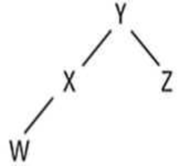
EBK COMPUTER SCIENCE: AN OVERVIEW
12th Edition
ISBN: 8220102744196
Author: BRYLOW
Publisher: PEARSON
expand_more
expand_more
format_list_bulleted
Concept explainers
Textbook Question
Chapter 8.3, Problem 9QE
Draw a diagram representing how the tree below appears in memory when stored using the left and right child pointers, as described in this section. Then, draw another diagram showing how the tree would appear in contiguous storage using the alternative storage system described in this section.

Expert Solution & Answer
Want to see the full answer?
Check out a sample textbook solution
Students have asked these similar questions
Show all the work
Construct a frequency polygon density estimate for the sample in Question 1, using bin width determined by Sturges’ Rule.
Show all the work
Chapter 8 Solutions
EBK COMPUTER SCIENCE: AN OVERVIEW
Ch. 8.1 - Give examples (outside of computer science) of...Ch. 8.1 - Prob. 2QECh. 8.1 - Prob. 3QECh. 8.1 - Prob. 4QECh. 8.1 - Prob. 5QECh. 8.2 - In what sense are data structures such as arrays,...Ch. 8.2 - Prob. 2QECh. 8.2 - Prob. 3QECh. 8.3 - Prob. 1QECh. 8.3 - Prob. 2QE
Ch. 8.3 - Prob. 3QECh. 8.3 - Prob. 4QECh. 8.3 - Modify the function in Figure 8.19 so that it...Ch. 8.3 - Prob. 7QECh. 8.3 - Prob. 8QECh. 8.3 - Draw a diagram representing how the tree below...Ch. 8.4 - Prob. 1QECh. 8.4 - Prob. 2QECh. 8.4 - Prob. 3QECh. 8.4 - Prob. 4QECh. 8.5 - Prob. 1QECh. 8.5 - Prob. 3QECh. 8.5 - Prob. 4QECh. 8.6 - In what ways are abstract data types and classes...Ch. 8.6 - What is the difference between a class and an...Ch. 8.6 - Prob. 3QECh. 8.7 - Suppose the Vole machine language (Appendix C) has...Ch. 8.7 - Prob. 2QECh. 8.7 - Using the extensions described at the end of this...Ch. 8.7 - In the chapter, we introduced a machine...Ch. 8 - Prob. 1CRPCh. 8 - Prob. 2CRPCh. 8 - (Asterisked problems are associated with optional...Ch. 8 - Prob. 4CRPCh. 8 - (Asterisked problems are associated with optional...Ch. 8 - Prob. 6CRPCh. 8 - Prob. 7CRPCh. 8 - Prob. 8CRPCh. 8 - Prob. 9CRPCh. 8 - Prob. 10CRPCh. 8 - Prob. 11CRPCh. 8 - Prob. 12CRPCh. 8 - Prob. 13CRPCh. 8 - Prob. 14CRPCh. 8 - Prob. 15CRPCh. 8 - Prob. 16CRPCh. 8 - Prob. 17CRPCh. 8 - Prob. 18CRPCh. 8 - Design a function to compare the contents of two...Ch. 8 - (Asterisked problems are associated with optional...Ch. 8 - (Asterisked problems are associated with optional...Ch. 8 - Prob. 22CRPCh. 8 - Prob. 23CRPCh. 8 - Prob. 24CRPCh. 8 - (Asterisked problems are associated with optional...Ch. 8 - Prob. 26CRPCh. 8 - Prob. 27CRPCh. 8 - Prob. 28CRPCh. 8 - Prob. 29CRPCh. 8 - Prob. 30CRPCh. 8 - Design a nonrecursive algorithm to replace the...Ch. 8 - Prob. 32CRPCh. 8 - Prob. 33CRPCh. 8 - Prob. 34CRPCh. 8 - Draw a diagram showing how the binary tree below...Ch. 8 - Prob. 36CRPCh. 8 - Prob. 37CRPCh. 8 - Prob. 38CRPCh. 8 - Prob. 39CRPCh. 8 - Prob. 40CRPCh. 8 - Modify the function in Figure 8.24 print the list...Ch. 8 - Prob. 42CRPCh. 8 - Prob. 43CRPCh. 8 - Prob. 44CRPCh. 8 - Prob. 45CRPCh. 8 - Prob. 46CRPCh. 8 - Using pseudocode similar to the Java class syntax...Ch. 8 - Prob. 48CRPCh. 8 - Identify the data structures and procedures that...Ch. 8 - Prob. 51CRPCh. 8 - In what way is a class more general than a...Ch. 8 - Prob. 53CRPCh. 8 - Prob. 54CRPCh. 8 - Prob. 55CRPCh. 8 - Prob. 1SICh. 8 - Prob. 2SICh. 8 - In many application programs, the size to which a...Ch. 8 - Prob. 4SICh. 8 - Prob. 5SICh. 8 - Prob. 6SICh. 8 - Prob. 7SICh. 8 - Prob. 8SI
Additional Engineering Textbook Solutions
Find more solutions based on key concepts
This optional Google account security feature sends you a message with a code that you must enter, in addition ...
SURVEY OF OPERATING SYSTEMS
In Exercises 61 through 66, rewrite the statements using augmented assignment operators. Assume that each varia...
Introduction To Programming Using Visual Basic (11th Edition)
Fill in the blanks in each of the following: Each parameter must specify both a(n) and a(n)
Java How to Program, Early Objects (11th Edition) (Deitel: How to Program)
Why is the study of database technology important?
Database Concepts (8th Edition)
Replace the loading system by an equivalent resultant force and specify where the resultants line of action int...
INTERNATIONAL EDITION---Engineering Mechanics: Statics, 14th edition (SI unit)
Like constructors, destructors cannot have a(n) __________ type.
Starting Out with C++ from Control Structures to Objects (9th Edition)
Knowledge Booster
Learn more about
Need a deep-dive on the concept behind this application? Look no further. Learn more about this topic, computer-science and related others by exploring similar questions and additional content below.Similar questions
- Show all the workarrow_forwardShow all the workarrow_forward[5 marks] Give a recursive definition for the language anb2n where n = 1, 2, 3, ... over the alphabet Ó={a, b}. 2) [12 marks] Consider the following languages over the alphabet ={a ,b}, (i) The language of all words that begin and end an a (ii) The language where every a in a word is immediately followed by at least one b. (a) Express each as a Regular Expression (b) Draw an FA for each language (c) For Language (i), draw a TG using at most 3 states (d) For Language (ii), construct a CFG.arrow_forward
- Question 1 Generate a random sample of standard lognormal data (rlnorm()) for sample size n = 100. Construct histogram estimates of density for this sample using Sturges’ Rule, Scott’s Normal Reference Rule, and the FD Rule. Question 2 Construct a frequency polygon density estimate for the sample in Question 1, using bin width determined by Sturges’ Rule.arrow_forwardGenerate a random sample of standard lognormal data (rlnorm()) for sample size n = 100. Construct histogram estimates of density for this sample using Sturges’ Rule, Scott’s Normal Reference Rule, and the FD Rule.arrow_forwardCan I get help with this case please, thank youarrow_forward
- I need help to solve the following, thank youarrow_forwardreminder it an exercice not a grading work GETTING STARTED Open the file SC_EX19_EOM2-1_FirstLastNamexlsx, available for download from the SAM website. Save the file as SC_EX19_EOM2-1_FirstLastNamexlsx by changing the “1” to a “2”. If you do not see the .xlsx file extension in the Save As dialog box, do not type it. The program will add the file extension for you automatically. With the file SC_EX19_EOM2-1_FirstLastNamexlsx still open, ensure that your first and last name is displayed in cell B6 of the Documentation sheet. If cell B6 does not display your name, delete the file and download a new copy from the SAM website. Brad Kauffman is the senior director of projects for Rivera Engineering in Miami, Florida. The company performs engineering projects for public utilities and energy companies. Brad has started to create an Excel workbook to track estimated and actual hours and billing amounts for each project. He asks you to format the workbook to make the…arrow_forwardNeed help completing this algorithm here in coding! 2arrow_forward
arrow_back_ios
SEE MORE QUESTIONS
arrow_forward_ios
Recommended textbooks for you
 Systems ArchitectureComputer ScienceISBN:9781305080195Author:Stephen D. BurdPublisher:Cengage Learning
Systems ArchitectureComputer ScienceISBN:9781305080195Author:Stephen D. BurdPublisher:Cengage Learning C++ for Engineers and ScientistsComputer ScienceISBN:9781133187844Author:Bronson, Gary J.Publisher:Course Technology Ptr
C++ for Engineers and ScientistsComputer ScienceISBN:9781133187844Author:Bronson, Gary J.Publisher:Course Technology Ptr C++ Programming: From Problem Analysis to Program...Computer ScienceISBN:9781337102087Author:D. S. MalikPublisher:Cengage Learning
C++ Programming: From Problem Analysis to Program...Computer ScienceISBN:9781337102087Author:D. S. MalikPublisher:Cengage Learning New Perspectives on HTML5, CSS3, and JavaScriptComputer ScienceISBN:9781305503922Author:Patrick M. CareyPublisher:Cengage LearningProgramming Logic & Design ComprehensiveComputer ScienceISBN:9781337669405Author:FARRELLPublisher:Cengage
New Perspectives on HTML5, CSS3, and JavaScriptComputer ScienceISBN:9781305503922Author:Patrick M. CareyPublisher:Cengage LearningProgramming Logic & Design ComprehensiveComputer ScienceISBN:9781337669405Author:FARRELLPublisher:Cengage Microsoft Visual C#Computer ScienceISBN:9781337102100Author:Joyce, Farrell.Publisher:Cengage Learning,
Microsoft Visual C#Computer ScienceISBN:9781337102100Author:Joyce, Farrell.Publisher:Cengage Learning,

Systems Architecture
Computer Science
ISBN:9781305080195
Author:Stephen D. Burd
Publisher:Cengage Learning

C++ for Engineers and Scientists
Computer Science
ISBN:9781133187844
Author:Bronson, Gary J.
Publisher:Course Technology Ptr

C++ Programming: From Problem Analysis to Program...
Computer Science
ISBN:9781337102087
Author:D. S. Malik
Publisher:Cengage Learning

New Perspectives on HTML5, CSS3, and JavaScript
Computer Science
ISBN:9781305503922
Author:Patrick M. Carey
Publisher:Cengage Learning

Programming Logic & Design Comprehensive
Computer Science
ISBN:9781337669405
Author:FARRELL
Publisher:Cengage

Microsoft Visual C#
Computer Science
ISBN:9781337102100
Author:Joyce, Farrell.
Publisher:Cengage Learning,
Computer Fundamentals - Basics for Beginners; Author: Geek's Lesson;https://www.youtube.com/watch?v=eEo_aacpwCw;License: Standard YouTube License, CC-BY